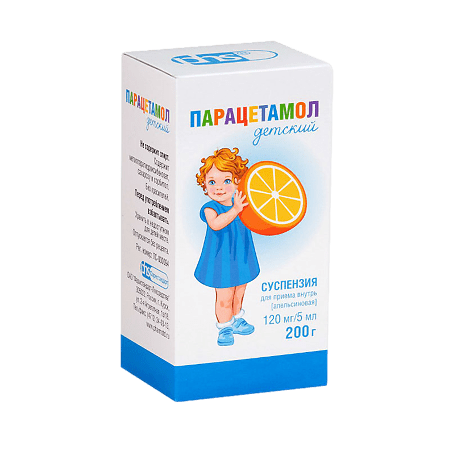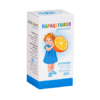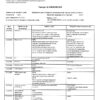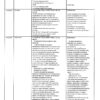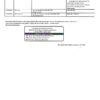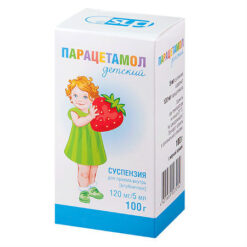No products in the cart.
Paracetamol for children, 120mg/5ml suspension 200 g
€4.00 €3.33
Out of stock
(E-mail when Stock is available)
Description
A non-narcotic analgesic has analgesic and antipyretic effects.
The drug blocks cyclooxygenase 1 and 2 in the central nervous system affecting the centers of pain and thermoregulation. In inflamed tissues cellular peroxidases neutralize the effect of paracetamol on cyclooxygenase, which explains the lack of significant anti-inflammatory effect. The drug has no adverse effect on water-salt metabolism and mucosa of the gastrointestinal tract. Pharmacokinetics:
Absorption – high time to reach maximum concentration – 05-2 hours maximum concentration – 5-20 mcg/ml. Binding with plasma proteins – 15%. Penetrates through the blood-brain barrier. Less than 2% of the dose taken by a nursing mother will penetrate into breast milk. The therapeutically effective plasma concentration of paracetamol is achieved when it is used at a dose of 10-15 mg/kg. It is metabolized in liver: 80% reacts in conjugation with glucuronic acid and sulphates with formation of inactive metabolites 17% undergoes hydroxylation with formation of 8 active metabolites, which conjugate with glutathione and then with cysteine and mercapturic acid and form inactive metabolites. The main cytochrome P450 isoenzymes for this metabolic pathway are CYP2E1 (predominantly) CYP1A2 and CYP3A4 (secondary role). If glutathione is deficient, these metabolites can block the enzyme systems of hepatocytes and cause their necrosis.
Additional metabolic pathways are hydroxylation to 3-hydroxyparacetamol and methoxylation to 3-methoxyparacetamol, which are subsequently conjugated to glucuronic and sulfuric acids.
In adults, glucuronidation predominates in newborns (including premature babies) and young children, sulfation. Conjugated metabolites of paracetamol (glucuronide sulfates and conjugates with glutathione) have low pharmacological (including toxic) activity.
The elimination half-life is 2-3 hours. Within 24 hours, 85-95% of paracetamol is excreted by the kidneys as glucuronides and sulfates 3% – unchanged. In elderly patients the clearance of paracetamol is decreased and the elimination half-life is increased.
Indications
Indications
Fever with infectious and inflammatory diseases.Pain syndrome of mild to moderate intensity of different genesis (including headache, migraine, toothache, neuralgia, myalgia, algodysmenorrhea; pain from injuries, burns).
Active ingredient
Active ingredient
Composition
Composition
Active ingredient: paracetamol – 120 mg.
Auxiliary substances: avicel RC-591 [microcrystalline cellulose, sodium carmellose] – 50 mg, xanthan gum (xanthan gum) – 7.5 mg, methyl parahydroxybenzoate (nipagin) – 5 mg, propylene glycol – 1 mg, sucrose (sugar) – 1650 mg, glycerol (glycerin) – 630 mg, sorbitol (food sorbitol) – 1128.75 mg, orange flavoring or strawberry flavoring – 6.5 mg, water (purified water) – up to 5 ml.
How to take, the dosage
How to take, the dosage
The drug is taken orally before meals in undiluted form with plenty of liquid. The drug should be shaken thoroughly before use. Frequency of intake is not more than 4 times a day with an interval of at least 4 hours.
The dose of paracetamol for children is calculated according to their age and body weight. The single dose of paracetamol is 10-15 mg/kg of body weight; the daily dose should not exceed 60 mg/kg of body weight.
Depending on the packaging the exact dosage of the drug is taken with measuring spoon or measuring syringe included in the package.
Depending on the age of “Paracetamol children” is prescribed in the following single doses:
– from 1 to 3 months – a single dose of 2.5 ml of suspension is used for symptomatic treatment of reactions to vaccination. If necessary, the dose can be repeated, but not earlier than 4 hours later. If the child’s body temperature does not decrease after the second dose, a doctor should be consulted.
The further use of the drug in children of the indicated age for treatment of postvaccinal hyperthermia, as well as its use in children aged 1-3 months for other indications is possible only under medical supervision. If it is necessary to use the drug in a prematurely born child of 1-3 months of age the drug should be prescribed only under a doctor’s recommendation.
The single oral doses for children aged 6-12 years are 250-500 mg, 1-5 years – 120-250 mg, from 3 months to 1 year – 60-120 mg, up to 3 months – 10 mg/kg.
The duration of treatment is not more than 3 days as an antipyretic and not more than 5 days as an analgesic. Continued treatment with the drug is possible only after consultation with the doctor.
Interaction
Interaction
Inducers of microsomal oxidation in the liver (phenytoin, ethanol, barbiturates, flumecinol, rifampicin, phenylbutazone, tricyclic antidepressants) increase the production of hydroxylated active metabolites that determine the possibility of hepatotoxic effect in small overdoses.
Microsomal oxidation inhibitors (including cimetidine) reduce the risk of hepatotoxic effects.
Simultaneous long-term administration of paracetamol in high doses and salicylates increases the risk of kidney or bladder cancer. Combination with chloramphenicol, increases the toxic properties of the latter.
It increases the effect of indirect anticoagulants and reduces the effectiveness of uricosuric drugs.
Prolonged use of barbiturates reduces the effectiveness of paracetamol.
Myelotoxic drugs increase the manifestation of hematotoxicity of paracetamol.
Ethanol promotes acute pancreatitis.
Long-term co-administration of paracetamol and nonsteroidal anti-inflammatory drugs increases the risk of “analgesic” nephropathy and renal papillary necrosis, the onset of terminal renal failure.
Diflunisal increases the plasma concentration of paracetamol by 50%, a risk of hepatotoxicity.
Special Instructions
Special Instructions
With caution, use in patients with hepatic and renal dysfunction, with benign hyperbilirubinemia, as well as in elderly patients.
In long-term use of paracetamol it is necessary to monitor the peripheral blood picture and the functional state of the liver.
It is used for treatment of premenstrual tension syndrome in combination with pamabrom (diuretic, xanthine derivative) and mepiramine (histamine H1-receptor blocker).
Contraindications
Contraindications
Hypersensitivity, period of infancy (up to 1 month).
With caution. Renal and hepatic insufficiency, benign hyperbilirubinemia (including Gilbert syndrome), viral hepatitis, alcoholic liver damage, alcoholism, diabetes (for syrup), pregnancy, lactation, older age, early breast age (up to 3 months).
Side effects
Side effects
The digestive system: rare – dyspeptic phenomena, with prolonged use in high doses – hepatotoxic effect.
Hematopoietic system: rarely – thrombocytopenia, leukopenia, pancytopenia, neutropenia, agranulocytosis.
Allergic reactions: rare – skin rash, itching, urticaria.
Overdose
Overdose
Symptoms: during the first 24 hours after ingestion – pale skin, nausea, vomiting, anorexia, abdominal pain; impaired glucose metabolism, metabolic acidosis. Symptoms of liver dysfunction may appear 12-48 hours after overdose.
In severe overdose – hepatic failure with progressive encephalopathy, coma, death; acute renal failure with tubular necrosis (including in the absence of severe liver damage); arrhythmia, pancreatitis.
Hepatotoxic effect in adults occurs when taking 10 g or more.
Treatment: administration of donators of SH-groups and precursors of glutathione synthesis – methionine within 8-9 hours after overdose and acetylcysteine – within 8 hours. The need for additional therapeutic measures (further administration of methionine, intravenous injection of acetylcysteine) is determined depending on the concentration of paracetamol in the blood, as well as the time elapsed after its administration.
Pregnancy use
Pregnancy use
Paracetamol penetrates through the placenta when taken in therapeutic doses the drug is safe for the fetus in high doses may have hepatotoxic effect, so it is necessary to strictly follow the dosing regimen.
In breastfeeding, the concentration in breast milk is low (1-2% of the maternal dose). No adverse effects on infants have been reported. Use is possible with strict adherence to the dosing regimen.
Similarities
Similarities
Additional information
| Shelf life | 3 years. |
|---|---|
| Conditions of storage | Store at a temperature not exceeding 25 ° C. Do not freeze! Store out of the reach of children. |
| Manufacturer | Pharmstandard-Leksredstva, Russia |
| Medication form | oral suspension |
| Brand | Pharmstandard-Leksredstva |
Other forms…
Related products
Buy Paracetamol for children, 120mg/5ml suspension 200 g with delivery to USA, UK, Europe and over 120 other countries.

